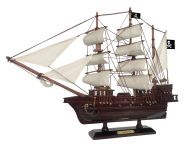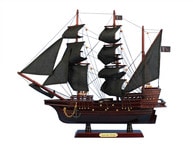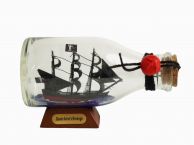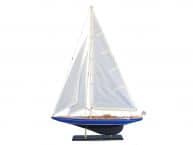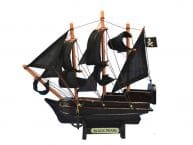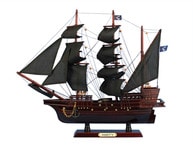|
|
Customers Also Shopped

|
|

|
Wooden Calico Jack's The William Model Pirate Ship 20"
John Rackham Becomes Calico Jack:
Made famous as the last vessel upon which the legendary pirate Calico Jack sailed, The William was a small Bahamian sloop of 12 tons, carrying four cannons. While her pirate history is quite brief, leading up to her capture are the fascinating lives of John Rackham, later Calico Jack, and his diverse crew. An Englishman born in Jamaica on December 21, 1682, the majority of John Rackham’s life is almost a complete mystery, as the first true records of his existence date to 1718. Previously a sailor, and perhaps a buccaneer, what is known about Rackham is that his legend was born during the final years of the Golden Age of Piracy. Sailing through the waters of the West Indies until 1720, Rackham was a true pirate of the Caribbean.
The earliest record of John Rackham places him as the quartermaster aboard the pirate Charles Vane’s sloop the Ranger in 1718. Raiding ships throughout the Bahamas, and along the east coast of North America, Vane lived the classic pirate lifestyle, though his time aboard the Ranger was short lived. Coming upon a large French man-o-war vessel off the coast of New York in November of 1718, Captain Vane chose to run while the majority of the crew, including quartermaster Rackham, wanted to attack. Out of 90 crew only 15 sided with Vane, though as Captain of the ship he declared that his orders were final. While the crew unhappily went along with Vane’s order to flee that day, on November 24th a vote was held in which Rackham and the majority of the crew stripped Vane of his captaincy, making Rackham new captain of the Ranger. In parting, however, Rackham granted Vane and his 15 loyal crew members one of their small sloops as well as enough supplies to last them until they could make port.
Eventually coming to be called Calico Jack, perhaps because of a preference for the unbleached cotton fabric from India, Rackham rose to fame as a pirate and captain as he sailed through the Caribbean. Attacking vessels throughout the area, generally close to the coasts, Calico Jack and his crew captured the Kingston as their flagship before continuing on to further victories over several larger vessels near Bermuda. Though the date is not known, around this time Calico Jack created what would become one of the most iconic emblems of piracy in history: the Jolly Roger. Consisting of a skull above two crossed cutlasses, the Jolly Roger flag came to be known and used throughout the Caribbean, and to this day is recognized for its distinct and unique design.
Piracy in the Caribbean:
While Calico Jack and his crew were sailing throughout the Caribbean, in 1718 England declared war on Spain, leading various English governors throughout the area to offer royal pardons as well as letters of marque; military papers granting pirates the chance to become privateers in the British Royal Navy. In 1719 Rackham sailed into Nassau, in the Bahamas, to take advantage of the general amnesty and to petition for his letters of marque. While granted his pardon, Nassau Governor Woodes Rogers did not feel that Rackham and his crew were capable of successfully attacking large Spanish galleons and denied him his letters.
Retiring from piracy, John Rackham spent the next year at port in New Providence, where he met the soon-to-be legendary Anne Bonny. The wife of another former pirate, James Bonny, Anne and John began an affair that would eventually lead to further life on the high seas. In February of 1720 the short war between the British and Spanish ended, leaving many sailors and former pirates looking for work. Around this same time Rackham and Anne Bonny had decided to run from their obligations on land; the former in search of pay, the latter from her husband. On August 22, 1720 the two, along with 10 other crew, rowed out into Nassau harbor and bordered the Bahamian sloop The William. Sailing through the Windward Passage, the renewed pirates escaped once again and began hunting the Caribbean.
The William and the Downfall of Calico Jack:
On October 1, 1720 Calico Jack’s crew seized two sloops off the coast of St. Dominique, and by mid month they had captured a large ship near Jamaica; a conquest that would soon lead to the pirates’ downfall. After Rackham and crew had attacked and taken the vessel, the Jamaican government contacted Captain John Barnet and tasked him with capturing the infamous pirate. Continuing along the Jamaican coast, Rackham took The William to the western-most tip of the island where they ran across a small ship of fisherman and turtle trappers. Propositioning the crew to exchange their catches for liquor, the fishermen and Rackham dropped anchor and a large drinking party was begun by all. Within a matter of hours, as night fell over the sea, Captain Barnet had caught up to The William, venturing a guess that this was the pirate ship he was looking for. After he called out to Rackham, and was answered with a cannon turning toward his own vessel, Barnet fired a broadside volley at The William and a short lived battle ensued.
Boarding The William, Barnet’s crew found little resistance as the only two pirates with any fight in them were Anne Bonny and the other female member, Mary “Mark” Read. While the other pirates were drunk and cowardly, Bonny and Read fought for their freedom while cursing out their weak male counterparts, even firing upon and killing one of them. Following the brief ordeal the pirate crew was seized and taken to Port Royal, Jamaica for trial. Though Anne Bonny and Mary Read were granted stays in their execution, claiming to be pregnant at the time, Rackham and the others were convicted of piracy and sentenced to death on November 16, 1720. The next day the ten were hung at Gallows Point, ending the brief yet legendary career of Calico Jack.
Following Rackham's death, few accurate accounts of The William exist, and while Mary Read in fact died of child-birth related causes some months later, Anne Bonny fled and disappeared from history. As his legacy Calico Jack left behind his emblematic Jolly Roger flag, as well as a career of piracy that has been taken up in novel and on the silver screen, most recently in the Disney blockbuster Pirates of the Caribbean.
 Handcrafted
Handcrafted Handcrafted
Handcrafted Handcrafted
Handcrafted Handcrafted
Handcrafted Handcrafted
Handcrafted Handcrafted Model Ships
Handcrafted Model Ships


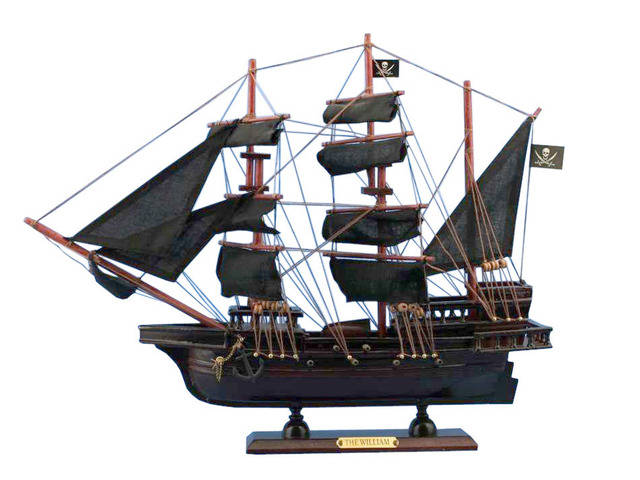

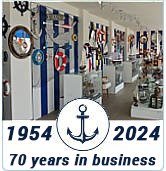







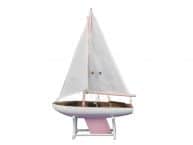
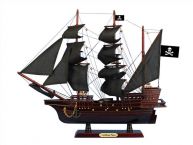
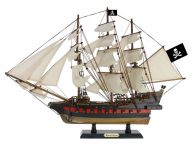
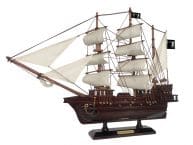
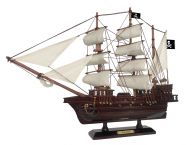
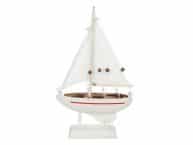
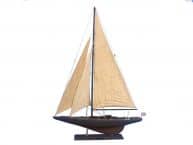
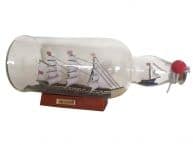
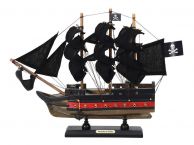
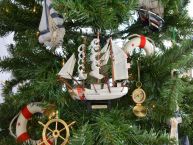
.jpg)

